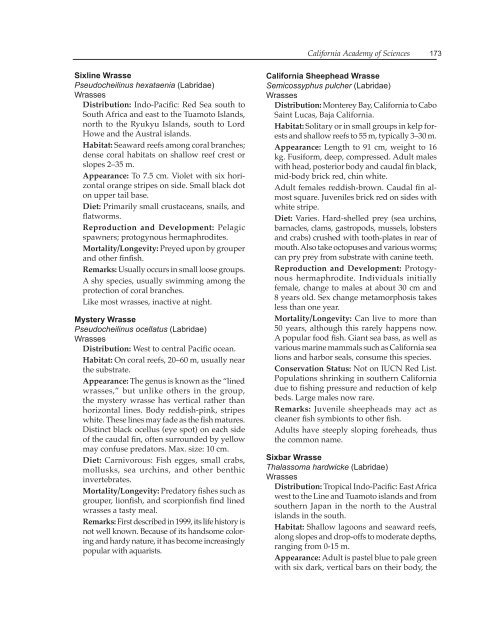THE STEINHART AQUARIUM - Gulf of Guinea Science ...
THE STEINHART AQUARIUM - Gulf of Guinea Science ...
THE STEINHART AQUARIUM - Gulf of Guinea Science ...
Create successful ePaper yourself
Turn your PDF publications into a flip-book with our unique Google optimized e-Paper software.
Sixline Wrasse<br />
Pseudocheilinus hexataenia (Labridae)<br />
Wrasses<br />
Distribution: Indo-Pacific: Red Sea south to<br />
South Africa and east to the Tuamoto Islands,<br />
north to the Ryukyu Islands, south to Lord<br />
Howe and the Austral islands.<br />
Habitat: Seaward reefs among coral branches;<br />
dense coral habitats on shallow reef crest or<br />
slopes 2–35 m.<br />
Appearance: To 7.5 cm. Violet with six horizontal<br />
orange stripes on side. Small black dot<br />
on upper tail base.<br />
Diet: Primarily small crustaceans, snails, and<br />
flatworms.<br />
Reproduction and Development: Pelagic<br />
spawners; protogynous hermaphrodites.<br />
Mortality/Longevity: Preyed upon by grouper<br />
and other finfish.<br />
Remarks: Usually occurs in small loose groups.<br />
A shy species, usually swimming among the<br />
protection <strong>of</strong> coral branches.<br />
Like most wrasses, inactive at night.<br />
Mystery Wrasse<br />
Pseudocheilinus ocellatus (Labridae)<br />
Wrasses<br />
Distribution: West to central Pacific ocean.<br />
Habitat: On coral reefs, 20–60 m, usually near<br />
the substrate.<br />
Appearance: The genus is known as the “lined<br />
wrasses,” but unlike others in the group,<br />
the mystery wrasse has vertical rather than<br />
horizontal lines. Body reddish-pink, stripes<br />
white. These lines may fade as the fish matures.<br />
Distinct black ocellus (eye spot) on each side<br />
<strong>of</strong> the caudal fin, <strong>of</strong>ten surrounded by yellow<br />
may confuse predators. Max. size: 10 cm.<br />
Diet: Carnivorous: Fish egges, small crabs,<br />
mollusks, sea urchins, and other benthic<br />
invertebrates.<br />
Mortality/Longevity: Predatory fishes such as<br />
grouper, lionfish, and scorpionfish find lined<br />
wrasses a tasty meal.<br />
Remarks: First described in 1999, its life history is<br />
not well known. Because <strong>of</strong> its handsome coloring<br />
and hardy nature, it has become increasingly<br />
popular with aquarists.<br />
California Academy <strong>of</strong> <strong>Science</strong>s<br />
173<br />
California Sheephead Wrasse<br />
Semicossyphus pulcher (Labridae)<br />
Wrasses<br />
Distribution: Monterey Bay, California to Cabo<br />
Saint Lucas, Baja California.<br />
Habitat: Solitary or in small groups in kelp forests<br />
and shallow reefs to 55 m, typically 3–30 m.<br />
Appearance: Length to 91 cm, weight to 16<br />
kg. Fusiform, deep, compressed. Adult males<br />
with head, posterior body and caudal fin black,<br />
mid-body brick red, chin white.<br />
Adult females reddish-brown. Caudal fin almost<br />
square. Juveniles brick red on sides with<br />
white stripe.<br />
Diet: Varies. Hard-shelled prey (sea urchins,<br />
barnacles, clams, gastropods, mussels, lobsters<br />
and crabs) crushed with tooth-plates in rear <strong>of</strong><br />
mouth. Also take octopuses and various worms;<br />
can pry prey from substrate with canine teeth.<br />
Reproduction and Development: Protogynous<br />
hermaphrodite. Individuals initially<br />
female, change to males at about 30 cm and<br />
8 years old. Sex change metamorphosis takes<br />
less than one year.<br />
Mortality/Longevity: Can live to more than<br />
50 years, although this rarely happens now.<br />
A popular food fish. Giant sea bass, as well as<br />
various marine mammals such as California sea<br />
lions and harbor seals, consume this species.<br />
Conservation Status: Not on IUCN Red List.<br />
Populations shrinking in southern California<br />
due to fishing pressure and reduction <strong>of</strong> kelp<br />
beds. Large males now rare.<br />
Remarks: Juvenile sheepheads may act as<br />
cleaner fish symbionts to other fish.<br />
Adults have steeply sloping foreheads, thus<br />
the common name.<br />
Sixbar Wrasse<br />
Thalassoma hardwicke (Labridae)<br />
Wrasses<br />
Distribution: Tropical Indo-Pacific: East Africa<br />
west to the Line and Tuamoto islands and from<br />
southern Japan in the north to the Austral<br />
islands in the south.<br />
Habitat: Shallow lagoons and seaward reefs,<br />
along slopes and drop-<strong>of</strong>fs to moderate depths,<br />
ranging from 0-15 m.<br />
Appearance: Adult is pastel blue to pale green<br />
with six dark, vertical bars on their body, the


